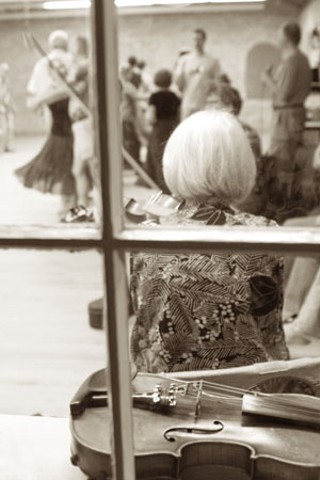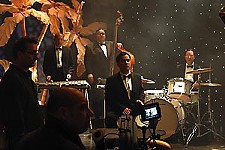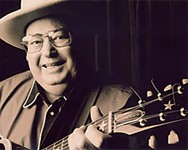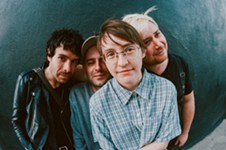Dueling Banjos
Old-Time Music: Better Than It Sounds
By Mark Rubin, Fri., March 30, 2007

No really, it's true.
If you stumble upon the Hancock Recreation Center some Wednesday evening, you'll encounter a group of musicians sitting near a corner of the dance floor and playing banjos, fiddles, and other instruments associated with Appalachian folk music. They'll be huddled in a circle, so close their knees are almost touching, fiddle bows flying precariously close to eye-poking level. Digging deep into their repertoire, eyes fixed in concentration on one another or closed altogether in some ecstatic state of higher consciousness, all are tied together, sawing and banging out a single rudimentary and repetitive dance tune.
Round and round they play the melody for the assembled dancers, mantralike, over and over for 10, even 20 minutes at a time, stopping only when the dancers finally give in to exhaustion. The casual observer won't understand what all the fuss is, this banjo skronk and scratchy fiddle squeak. Yet by simply listening, they'll be missing the point entirely. This here is old-time music.
Now the term "old-time music" could be properly applied to lots of things. For some, it evokes images of barbershop quartets or even what we call bluegrass today. It can also relate to points of reference, culturally and geographically. It can mean "Cajun" in South Louisiana and "polka" in Milwaukee, Wis. The Texas Old Time Fiddlers Association promotes a flashy native Texas style of playing they call "old-time fiddling." That's not what's going on at the HRC tonight.
This brand of old-time music is performed in the style of Appalachian and Southern American fiddle culture, based in the musical tradition of Scotch-Irish immigrants of the 18th and 19th centuries and informed by the African-American experience, of which the banjo is the most obvious influence. Said banjo is played in "clawhammer" style, a rhythmic strumming style that predates modern bluegrass. Much like its Irish traditional cousin, OTM instrumentation focuses on the melody, while the rhythmic drive of the fiddle and banjo creates an incredibly propulsive dance music.
Because of the banjo and fiddle and its close attachment to Southern culture, OTM is often mistaken for bluegrass, defined simply as music played in the style as originally performed by Kentucky's Bill Monroe and his band, which prominently featured the melodic three-string banjo of Earl Scruggs. Modern derivatives have sprung up over time, and in the contemporary music press, the term has been applied to just about anything remotely roots-oriented. Bluegrass may be "old-timey," but it isn't OTM. Scratch an OTM musician, however, and you will find someone who began in bluegrass.
Bluegrassers in turn have had a somewhat rancorous relationship with fans of an earlier sound. When I first started playing bluegrass myself, I wondered what this OTM was that I was hearing about. They liked to say, "It's just like bluegrass, only played poorly." This joke belies a simple truth: Both genres sprang from the same well in many respects. A simplistic explanation is to paint OTM as the unsophisticated country rube and bluegrass as its jazzed-up, citified cousin.
A clumsy analogy maybe, but what's clear is that where bluegrass was, and in some cases continues to be, music of commercial interest, OTM remains largely of and for informal social gatherings and dances. What's certain, on the other hand, is that musicians and fans who fall for OTM find in it a hook that digs deep and crosses cultural and even generational lines. When two OTM pickers happen across each other, no matter where, they'll get together for a tune or two.
Old-Time Herald
What is it about Austin, Texas, as far removed from Appalachia as NYC, that there's a vibrant community of folks dedicated to playing OTM? Apparently what we have that other urban cities don't is the Austin Friends of Traditional Music, which has become a hothouse of shared interest and musical connectivity.
One of AFTM's founders, Bernard Mollberg, came to traditional music in the wake of the first "Great Folk Music Scare" of the Sixties, when many urban-born musicians discovered the folk music of rural America. Mollberg's household had no musicians, but he was drawn to roots music at an early age. "When I saw Bonnie and Clyde, with its bluegrass soundtrack, I had to learn more about that sound. It seemed alien but extremely familiar all at once."
The Smithsonian Folklife Festival in Washington, D.C., in 1970, with performances by Doc Watson and others, sealed the deal. Moving to Austin in 1971, Mollberg considered becoming a folklorist but instead fell into string-instrument repair. Mollberg cultivated his musical interest with locals Doc Hamilton, David Polacheck, Elizabeth Pittman, and David Allen, and together they founded the AFTM in 1974. "In those days, access to traditional music was quite limited compared to the multimedia world of today," points out Mollberg. Indeed, these folks had little information to work with, so by banding together, they increased their circles of mutual study.
Today, AFTM maintains a Web site (see sidebar), a publication, and hosts both the popular Midwinter Festival at the Dougherty Arts Center and the newly minted Austin String Band Festival each October at Camp Ben McCullough. AFTM also hosts a series of house concerts and a regular jam session at Threadgill's World Headquarters every second Sunday of the month. Quite an achievement for a group a friends that got together at somebody's house more than 30 years ago to play some hillbilly tunes.
Banjo picker Jerry Haggins is a good example of someone who came to Austin for school but stayed for the OTM. Growing up in Arlington, Haggins came to the banjo first and in the same way many of his generation did.
"I had gotten a banjo on my 17th birthday, and I thought it was really cool that you could make your own music," he says, recalling the Seventies. "At the time 'Dueling Banjos' was on the radio, and it sounds like a cliché today, but I thought it was just thrilling. It just so happened that the little local music shop my mom and I went to had a five-string banjo.
"I was obsessed. You know, in a 17-year-old way, so I found a record store in Dallas, and that's where I found my first 'old-time' LP. It was in the tiny little blip of a bluegrass bin at the record store, but I was entranced by it."
Haggins' interest blossomed when he moved to Austin in 1991.
"At about the same time I moved here, I picked up a copy of The Old-Time Herald, which had an Austin issue," continues Haggins. "In it there was an article that mentioned several local events and musicians in particular. I went, and I was surprised at how welcoming they all were. In Philadelphia I had been to a couple of parties where my playing wasn't up to other people's standards, and they were nice and all, but I didn't go back. At this thing, these folks were more open. It was mighty welcoming from the get-go."
Not a Career Path
One of the foundational attractions of OTM is its easy entrée into a ready-built community. With the celebrated decline of "traditional" familial values and the assimilation of many cultures into the greater American milieu, this narrow focus on one kind of collaborative music-making allows people of diverse backgrounds to create their own village, if you will. One with its own mores and rules, maybe, but open to just about anyone. The only cost of admission is your love of the music and your desire to play it with others.
At the dances and jam sessions over the years, I'm always struck by the pronounced lack of ego and absence of musical snobbery that one might normally encounter at similar gatherings of other genres of music. Given the traditional, learn-by-doing nature of OTM and the recognition that everyone began by playing awfully at first, jam sessions are marked by every level of instrumental acumen, from rank amateur to genuine professional-level musicianship. If you've come to fiddle, then by golly, rosin your bow and play it.
That said, that very lack of ego can spiral into a curious phenomenon of persuasive self-deprecation. A popular T-shirt sold at festivals proclaims, "Old Time Music: Better Than It Sounds," and ultimately that may be the long and short of it. While many people, the AFTM included, work hard to promote appreciation for this music, a generous portion of those who play it seems resigned to languish in commercial and popular obscurity. Even Haggins notes, "It's not a career path. I can't imagine it could be."
This doesn't appear to factor into the newest and growing generation of younger musicians that's leapt into the genre with all the zeal associated with recent converts. In a fundamental way, they're operating as if this is the best music in the whole world, and they're ready to go out into the clubs, make CDs, and start Web sites in order to share it with anybody and everybody.
Where older OTM pickers exist in a comfortably constructed social network of house concerts and informal parties, this new batch of enthusiasts is far more interested in forming bands, eager to take the music into nightclubs. Problem is the notion of playing avocational music as a vocation is anathema to many in the established OTM community. That's where a generation gap may be most pronounced.
"When a young band gets some kind of momentum, there's a lot of grumbling," nods Haggins. "These young bands like the Freight Hoppers and now Uncle Earl put on a good show, and they entertain people. They're really great old-time musicians; they truly are. I've heard some people my age say, 'Well, they don't really play that well – their version of that tune isn't really the best version.' But I just think it's all sour grapes.
"We could all play in our room and all, but we like to play in front of other people. Supposedly, you aren't really destined to do that in old-time music, so when somebody's getting crowds, there's some backlash, and it's not pretty."
NTM
For newer acolytes, the context of OTM can be very different. Silas Lowe is a recent transplant to Austin and a fervent OTM convert. Raised in a musical family, Lowe was primed for roots music by folk rock.
"When I started to hear where that music came from, it really blew my mind, and I fell in love pretty quickly," enthuses Lowe, who, like nearly every other OTMer before him, got his start in bluegrass. "In looking for this music and its roots, I came across hippie-era stuff, like the Harry Smith anthology and records by the Holy Modal Rounders."
Picking up the guitar and banjo, Lowe finally settled on the mandolin.
"Around 2001, I started playing with these kids in college in western Massachusetts, and we'd sit around and drink whiskey and play bluegrass. We'd sit and listen to every record we could find. We were in that 'academic' mode where it was fascinating to try and put it all together and how you could have recordings of the same tune turn up almost 2,000 miles away and be so different."
Sound familiar? Consult Bob Dylan's Chronicles if not; the folk explosion (implosion?) of the early Sixties traces its origins in precisely the same manner. For Lowe, however, the term OTM doesn't jibe with his and friends' research.
"I guess it's convenient in a sense that people know what you are talking about, generally," he acknowledges. "But I think that's hurt old-time music in another sense. It's been pigeonholed, so at this point that term has come to mean one thing: North Carolina fiddle music played for hours at a time with no singing. It lacks the intensity that I was attracted to originally in the old recordings. If you want to play like the old guys, you have to play with passion and intensity.

"You gotta like lay into it."
To Lowe's ears, what gets played today is a new genre altogether. Call it "new-time music." Granted, Lowe is referring to recorded examples that very few modern OTMers have mastered. And why should they? To many, this newer breed and their NTM serves a social function, not a gig. Haggins understands all too well.
"I don't think anyone would deny that they'd love to have a nice recording of what they do," he points out. "But everyone I talk to that has a CD out is always disappointed with it. They always say the music is best played live and without a machine going."
Intensity is the entrée for this new generation, which inspires the same musicians who, at an earlier time, might have started punk bands. Indeed, a great many of this younger generation are former punk rockers or were at the very least introduced to the genre from transitional acts that incorporated OTM into their bag – bands like the Horseflies, Knitters, and even my own Bad Livers, who, truth to tell, recorded far more OTM than anything that could be described as bluegrass.
Clawhammer Banjo
When punk rock is just another commodity that can be purchased at the local mall, what could be more counterculture today than a banjo? These OTM punks are drawn to the raw emotion and wild abandon found in the 78s of pioneer recordings that have now been digitized for mass consumption. And there's the distinction between generations: the readier accessibility to historical recordings than any generation prior.
A simple Web search answers questions and adds context for today's OTM fan at a level previous generations could scarcely imagine. Google "clawhammer banjo" and see what you get. Thanks to the research and generous spirit of roots enthusiasts before them, today's players are now able to examine the entire length and breadth of American folk music in all its marvelous varieties. In the same way that radio and recordings forever changed how music and culture was transmitted, the Internet now allows contemporary musicians and all those who follow the tools to consume OTM. The old-fashioned transmission of culture via oral tradition, colloquially called the "folk process," has been changed profoundly and irrevocably.
"You're kind of a scholar if you are playing this music and you didn't grow up with it," posits Lowe. "Fundamentally it's a community-based form of music, and if you're trying to play a certain kind of fiddle music and you've taught yourself to do so off of records, you're a scholar. But there's a disconnect there.
"The cats you're learning from on record were part of a continuous line of music learned by ear. Then it just stopped. This folk revival came along, people learned from records and turned themselves into scholars, and now they've been scholars for so long that they've created little communities.

"And it's pretty amazing how genuinely eager they are to impart their knowledge. I've found this community of tremendously talented people who are perfectly willing to sit down and show you literally everything they know."
If you need a good example of the folk process in Austin today, look to Sarah Jarosz. The preternaturally talented young Jarosz played an AFTM show in 2003 at the age of 11. She's made her first musical steps as a bluegrass mandolinist, but lately she's turned her attention to OTM's five-string banjo.
"The stark honesty of old-time music is something that's rarely found in these days of modern technology and overproduced music," explains Jarosz, "but I believe it's that honesty people long for. Old-time music definitely fulfills that longing. I immediately fell in love with the whole atmosphere – movement, energy, and joy."
In fact, the banjo she plays was built for her by none other than AFTM founder Bernard Mollberg. Close the circle. ![]()
Where To Go To Participate Locally
• Second Sunday of the Month Jam Session at Threadgill's World Headquarters, 2-5pm
• Hancock Recreation Center weekly Contra Dance, with live music, every Wednesday 8-10pm
• AFTM Yahoo Group, www.groups.yahoo.com/group/aftm
What Bands To See Locally
• Double Eagle String Band
• Dan & Christy Foster
• Ralph White
• Hold 'er Newt
• Love Gone Cold
• Pistol Love Family Band
• Sharon Sandomirsky
• Sarah Jarosz
National Acts To Check Out
• Foghorn String Band
• Uncle Earl
• Old Crow Medicine Show
• Crooked Jades
• Dirk Powell
• Ginny Hawker & Tracy Schwarz
Seminal Recordings
• Clarence Ashley & Doc Watson: The Original Folkways Recordings, 1960-1962
• Classic Old-Time Music From Smithsonian Folkways Recordings
• The Harry Smith Project: Anthology of American Folk Music Revisited, Smithsonian Folkways
• Many, many collections on Yazoo, County, Document, and Old Hat Records
Online Resources
• Austin Friends of Traditional Music: www.aftm.us/index.htm
• Fiddler David Lynch hosts the informative old-time music home page that highlights performers both contemporary and historical with recordings and essays: www.oldtimemusic.com.
• Home page of the national publication The Old-Time Herald, which has become the de facto house organ for news and reviews of all things old-time: www.oldtimeherald.org.
• Pete's brother Mike Seeger hosts an informative site with his writings on the subject: www.mikeseeger.info/html/whatis.html.
• Roots of American Fiddle Music: www.1001tunes.com
• Digital Library of Appalachia: www.aca-dla.org/dlamusic/dlamusic.html
• Smithsonian Center for Folklife and Cultural Heritage: www.folklife.si.edu/index.html
• Folk Music Index: www.ibiblio.org/folkindex
Online Radio
• Sugar in the Gourd: www.sugarinthegourd.com
• Venerable Music Radio: www.venerablemusic.com/samphpweb/playing.php
• Honking Duck 78rpm Archive: www.honkingduck.com/78s











